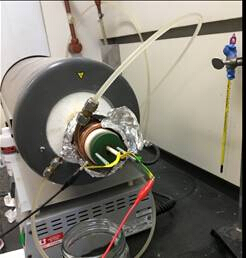Electrochemical Impedance Spectroscopy
Genel Bakış
Source: Kara Ingraham, Jared McCutchen, and Taylor D. Sparks, Department of Materials Science and Engineering, The University of Utah, Salt Lake City, UT
Electrical resistance is the ability of an electrical circuit element to resist the flow of electricity. Resistance is defined by Ohm's Law:
 (Equation 1)
(Equation 1)
Where  is the voltage and
is the voltage and  is the current. Ohm's law is useful for determining the resistance of ideal resistors. However, many circuit elements are more complex and can't be described by resistance alone. For example, if an alternating current (AC) is used then the resistivity will often depend on the frequency of the AC signal. Instead of using resistance alone, electrical impedance is a more accurate and generalizable measure of a circuit element's ability to resist the flow of electricity.
is the current. Ohm's law is useful for determining the resistance of ideal resistors. However, many circuit elements are more complex and can't be described by resistance alone. For example, if an alternating current (AC) is used then the resistivity will often depend on the frequency of the AC signal. Instead of using resistance alone, electrical impedance is a more accurate and generalizable measure of a circuit element's ability to resist the flow of electricity.
Most commonly, the goal of electrical impedance measurements is the deconvolution of a sample's total electrical impedance into contributions from different mechanisms such as resistance, capacitance, or induction.
Prosedür
- Obtain a test module and hook it up to the EIS instruments via two electrodes. The test module, pictured in Figure 3, provides data that can be used to model a simple, known circuit. It can be used to confirm that the wires are hooked up to the machine correctly and that all the machinery parts are functioning.

Figure 3: Test module.
Sonuçlar
Results of EIS are often presented in a Nyquist plot, which shows real impedance versus complex impedance at each frequency tested. The plot of the experiment ran can be seen in Figure 6.

Figure 6: Screenshot of computer after Nyquist plot was obtained.
Başvuru ve Özet
Electrochemical Impedance Spectroscopy is a useful tool for determining how a new material or device impedes the flow of electricity. It does this by applying an AC signal through the electrodes connected to the sample. The data is collected and plotted by the computer in the complex plain. With the help of software, the graph can be modeled after specific parts of a circuit. This data can often be very complicated and requires careful analysis. This technique, however complex, is an extremely useful non-destructive mean
Etiketler
Atla...
Bu koleksiyondaki videolar:

Now Playing
Electrochemical Impedance Spectroscopy
Materials Engineering
23.4K Görüntüleme Sayısı

Optical Materialography Part 1: Sample Preparation
Materials Engineering
15.6K Görüntüleme Sayısı

Optical Materialography Part 2: Image Analysis
Materials Engineering
11.1K Görüntüleme Sayısı

X-ray Photoelectron Spectroscopy
Materials Engineering
21.9K Görüntüleme Sayısı

X-ray Diffraction
Materials Engineering
89.7K Görüntüleme Sayısı

Focused Ion Beams
Materials Engineering
9.0K Görüntüleme Sayısı

Directional Solidification and Phase Stabilization
Materials Engineering
6.7K Görüntüleme Sayısı

Differential Scanning Calorimetry
Materials Engineering
38.6K Görüntüleme Sayısı

Thermal Diffusivity and the Laser Flash Method
Materials Engineering
13.4K Görüntüleme Sayısı

Electroplating of Thin Films
Materials Engineering
20.2K Görüntüleme Sayısı

Analysis of Thermal Expansion via Dilatometry
Materials Engineering
16.0K Görüntüleme Sayısı

Ceramic-matrix Composite Materials and Their Bending Properties
Materials Engineering
8.4K Görüntüleme Sayısı

Nanocrystalline Alloys and Nano-grain Size Stability
Materials Engineering
5.2K Görüntüleme Sayısı

Hydrogel Synthesis
Materials Engineering
23.8K Görüntüleme Sayısı
JoVE Hakkında
Telif Hakkı © 2020 MyJove Corporation. Tüm hakları saklıdır

